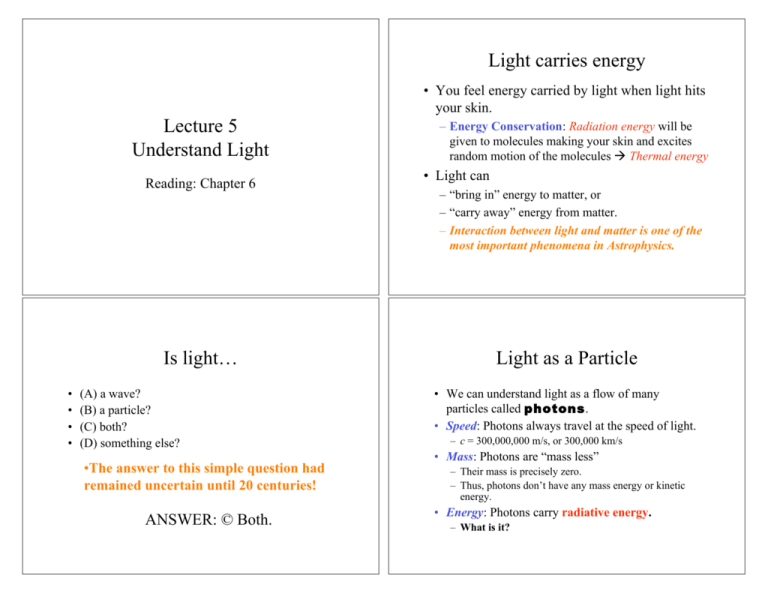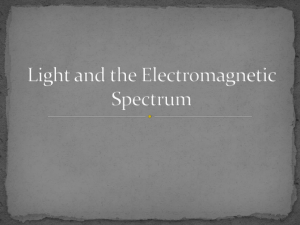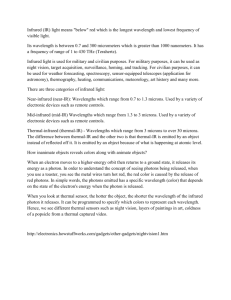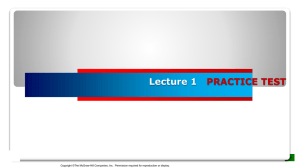Lecture 5 Understand Light Light carries energy Is light… Light as a
advertisement

Light carries energy Lecture 5 Understand Light Reading: Chapter 6 Is light… • • • • (A) a wave? (B) a particle? (C) both? (D) something else? •The answer to this simple question had remained uncertain until 20 centuries! ANSWER: © Both. • You feel energy carried by light when light hits your skin. – Energy Conservation: Radiation energy will be given to molecules making your skin and excites random motion of the molecules ! Thermal energy • Light can – “bring in” energy to matter, or – “carry away” energy from matter. – Interaction between light and matter is one of the most important phenomena in Astrophysics. Light as a Particle • We can understand light as a flow of many particles called photons. • Speed: Photons always travel at the speed of light. – c = 300,000,000 m/s, or 300,000 km/s • Mass: Photons are “mass less” – Their mass is precisely zero. – Thus, photons don’t have any mass energy or kinetic energy. • Energy: Photons carry radiative energy. – What is it? Radiative Energy • All photons have the same speed. • Photons don’t have any mass. • Do these facts imply that all photons have the same radiative energy? No. Light as a Wave • Key concepts – Wavelength measured in length – Frequency measured in “hertz” • To understand the radiative energy, we need to think of light as waves. Light as a Wave • For a wave, its speed: – s=f! – f is frequency – ! is wavelength • But the speed of light is a constant, c. • For light: – f!=c • The higher f is, the smaller ! is, and vice versa. • Our eyes recognize f (or !) as color! What is Radiative Energy? • Every photon has the radiative energy, which is proportional to its frequency, f: –Ephoton = h f – h is Planck’s constant = 6.6x10-34 joule x sec. • Or, inversely proportional to its wavelength, ! –Ephoton = h c/! • Light was thought to be a wave until Planck and Einstein discovered that it also behaves as a particle with the energy given above. (Planck, 1990; Einstein, 1902). Radiative Energy and Spectrum: Why UV Radiation is an Enemy! Light and Matter • Light can be – – – – • Bluer light carries more energy; thus, UV radiation damages skins more badly than the visible light. X-rays and gamma-rays can be dangerous! • On the other hand, IR radiation carries less energy, and radio waves are very low energy. Emission and Absorption • Emission lines and absorption lines are golden tools of Astronomy • Specific atoms, such as hydrogens or carbons, emit or absorb photons with specific energy (i.e., specific wavelength). • Therefore, from those lines, we can tell what elements emitted or absorbed the photons. Emitted, Absorbed, Transmitted, or Reflected by matter. • This “interaction” between matter and light leaves fingerprints of matter in light. – By measuring properties of light, we can learn about the matter that has interacted with the light we observe. – Astronomy! Thermal Radiation • Not just lines! There are“continuous emission” spectra. • One example is thermal radiation. – Imagine gas in which atoms are moving randomly. – If the gas is thin (or transparent), then the atoms in the gas emit or absorb photons only once or twice, resulting in lines. – If the gas is dense (or opaque), then the atoms in the gas emit and absorb photons frequently. – The random motion of the atoms “smear out” the line features, resulting in a characteristic continuous spectrum, called the black-body spectrum. • The shape of the black-body spectrum is determined only by temperature --> we can use this fact to determine temperature of the gas. 1. Hotter objects emit more total radiation per unit surface area. Black Body " Stephan-Boltzmann Law 4 " Energy per area = "T ¬ " is the StefanBoltzmann constant = 5.7x10-8 Watts/(m2 K4) 2. Hotter objects emit bluer photons (with a higher average energy.) " Wien Law ¬ !max = 2.9 x 106 / T(K) [nm] The Doppler Effect 1. Light emitted from an object moving towards you will have its wavelength shortened. BLUESHIFT 2. Light emitted from an object moving away from you will have its wavelength lengthened. REDSHIFT 3. Light emitted from an object moving perpendicular to your line-of-sight will not change its wavelength. The Doppler Effect The Doppler Effect #! v = ! c Measuring Rotational Velocity Measuring Radial Velocity • We can measure the Doppler shift of emission or absorption lines in the spectrum of an astronomical object. • We can then calculate the velocity of the object in the direction either towards or away from Earth. (radial velocity) Redshift & Expansion of the Universe • Since the Universe is expanding, most of galaxies are moving away from us. • Their emission and absorption lines are redshifted. • The amount of redshift is larger for more distant galaxies --> redshift can be used as a distance indicator. Next Lecture: The Solar System! Reading: Chapter 8 •Before next lecture: Don’t forget to put your homework in the box before you come into this room. No homework will be accepted after the class! •Today: Don’t forget to pick up your quiz from the box before you leave this building.







